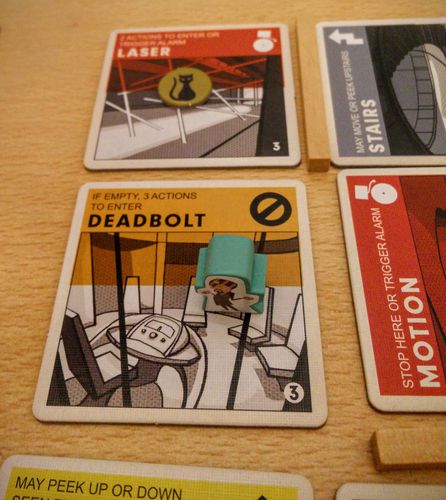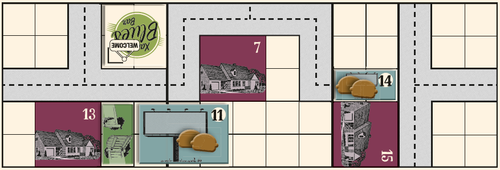
Explaining a joke is like dissecting a frog. You understand it better but the frog dies in the process. —E.B. White
We’ve been playing Burgle Bros, which means I’ve been thinking about humor in games. This is because Burgle Bros may be the funniest game I have played. There are two ways a game can be funny: The humor itself can be the primary mechanic of the game, as with most party games; Or, the humor can be embedded in the gameplay and arise naturally through the mapping of the simulation onto the real world. I’ll be focusing on the latter.
Burgle Bros comes with a thin rulebook, which leads to many ambiguities, but also guarantees that Fowers & co avoid explaining the joke. Instead, the joke becomes obvious to the players during play. To see what I mean, let’s dissect a couple frogs from Burgle Bros.
The Raven is a character that has a bird which can be used to slow the movement of the patrolling guard. These facts are presented to the player, and the player is left to fill in the blanks as to why the bird slows the guard: The bird makes a noise, or otherwise distracts the guard, which slows his pace. If the rulebook or character card told us this, we would accept it as Fact™ and think nothing of it. Instead, the player is trusted to figure it out themself, which injects engagement, humor, and is good thematic game design.
Similarly, the tiara is an item of loot you can retrieve from a safe. The bearer of the tiara loses stealth when moving near a guard. Once more, the facts are stated and the player is left to twig that the glinting diamonds of the tiara catch the eye of the guard in the darkness. The fact that the guard sees anything at all suggests the burglar has decided to wear the tiara rather than simply placing it in a sack. Again, Burgle Bros respects its audience by not explaining the joke, and the game is stronger for it.
Both of these examples are clever, thematic game design, but humor can also be baked into the soul of the game design itself. Burgle Bros exhibits this, too. An example:

The player pictured has lost the cat to the laser-alarmed room to the north, and must retrieve it to escape. However, entering a laser-alarmed room costs 2 (of 4 total) actions or else the alarm triggers, and returning to the deadbolted room costs 3 actions. So the player either retrieves the kitty and sets off the alarm, or gets the kitty and waits it out because he can’t get back through the deadbolt on this turn. This is a funny scene, and arrives organically through gameplay without any scripted or forced comedy. The predicament would still be funny without any of its thematic trappings.
Another great example of not dissecting the frog is Food Chain Magnate. The rules lay out the mechanics of the game, and it’s not until you begin playing that you realize the humor of situations like this:

By placing billboards smack up against the sides of houses you create an uncontrollable burgerlust among the denizens, which can only be sated with burgers and nothing else. This is hilarious mental imagery, and Splotter does well by letting the players discover the absurdity instead of highlighting it in the rules. In Roads & Boats, too, the 2 geese + 1 paper -> philosophy conversion is laid out without fanfare, but provides one of the more humorous and more magical parts of the game’s design.
Games do not need to be thematic designs to be funny. Modern Art by the great theme-paster Knizia is a perfect example. The whole endeavor is a marvelous joke about the inherent valuelessness of modern art. The joke would lose its humor entirely if this was ever stated in the rules. The straight man often delivers the funniest lines, and fortunately Knizia/Mayfair realized this.
That old chestnut Settlers of Catan also does a great job of not killing the frog. Besides exchanging “wood for sheep”, the absurdity of many of the game rules adds delight and humor throughout. New inductees often comment on how funny it is to build a settlement from a piece of wheat, a solitary brick, a sheep, and a couple logs. The players can make the rationalization necessary (agriculture, building materials, livestock, and fuel), but by omitting it in the rules the game is immediately funnier and more engaging.
There are plenty of games that do kill the frog. Every time it comes off like someone saying, “Get it? Get it?!” after a joke. So, please: Don’t kill the frog. Let the humor of the game stand on its own merit. If it falls down, it probably wasn’t that strong to begin with.
tags: boardgames humor frogs